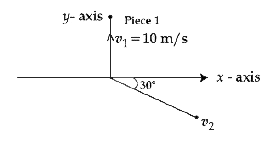A ball of mass 100g moving at a speed of 12 m strikes another ball of mass 200 g at rest. After the collision both the balls move with a common velocity. Find the common velocity.
Let the common velocity of the two balls be 'v'.
Frow law of conservation of momentum,
Topper's Solved these Questions
- DYNAMICSBook:PEARSON IIT JEE FOUNDATIONChapter:DYNAMICSExercise:EXAMPLE
Explore 11 Videos
- DYNAMICSBook:PEARSON IIT JEE FOUNDATIONChapter:DYNAMICSExercise:TEST YOUR CONCEPTS(VERY SHORT ANSWER TYPE QUESTIONS)
Explore 31 Videos
- DYNAMICSBook:PEARSON IIT JEE FOUNDATIONChapter:DYNAMICSExercise:Level 2
Explore 21 Videos
- CHEMICAL EFFECTS OF ELECTRIC CURRENTBook:PEARSON IIT JEE FOUNDATIONChapter:CHEMICAL EFFECTS OF ELECTRIC CURRENTExercise:COMPETITION CORNER (MCQ)
Explore 48 Videos
- ELECTRICITYBook:PEARSON IIT JEE FOUNDATIONChapter:ELECTRICITYExercise:CONCEPT APPLICATION (Level 3)
Explore 10 Videos
Similar Questions
A ball of mass 100g moving at a speed of 12 m s−1 strikes another ball of mass 200 g at rest. After the collision both the balls move with a common velocity. Find the common velocity.
View SolutionA ball of mass 100g moving at a speed of 12 m s−1 strikes another ball of mass 200 g at rest. After the collision both the balls stick to each other and move with a common velocity. Find the common velocity.
View Solution
Knowledge Check
A ball of mass 1 kg moving with a velocity of 0.4 ms−1 collides with another stationary ball. After the collision, the first ball moves with a velocity of 0.3ms1 in a direction making an angle of 90∘ with its initial direction. The momentum of the second ball after the collision will be (in kg ms−1)
A0.1B0.3C0.5D0.7A ball of mass 10 kg is moving with a velocity of 10 m / s . It strikes another ball of mass 5 kg which is moving in the same direction with a velocity of 4 m / s . If the collision is elastic, their velocities after the collision will be, respectively
A6m/s, 12m/sB12m/s, 6m/sC12 m/s, 10 m/sD12m/s, 25m/sA ball of mass m moving with a velocity v undergoes an oblique elastic collision with another ball of the same mass m but at rest. After the collision if the two balls move with the same speeds , the angle between their directions of motion will be:
A30∘B60∘C120∘D90∘
A ball of mass 100g moving at a speed of 12 m s−1 strikes another ball of mass 200 g at rest. After the collision both the balls stick to each other and move with a common velocity. Find the common velocity.
View SolutionA ball of mass 0.50 kg moving at a speed of 5.0 m/s collides with another ball of mas 1.0 kg. After the collision the balls stick together ane remain motionless. What was the velocity of the 1.0 kg block before the collision?
View SolutionA ball of mass 10 kg moving with a velocity 10√3m/s along the x-axis, hits another ball of mass 20 kg which is at rest. After the collision, first ball comes to rest while the second ball disintegrates into two equal pieces. One piece starts moving along y-axis with a speed of 10 m/s. The second piece starts moving at an angle of 30 with respect to the x-axis. The velocity of the ball moving at 30∘ with X-axis is x m/s. The configuration of pieces after collision is shown in the figure below.
The value of x to the nearest integer is ______

View SolutionA ball of mass 100 g is moving with a velocity of 100 msec−1. Find its wavelength.
View SolutionA metal ball of mass 2kg moving with speed of 36Km/h has a collision with a stationary ball of mass 3kg. If ater collision, both the ball move together, the loss in Kinetic energy due to collision is :
View Solution
